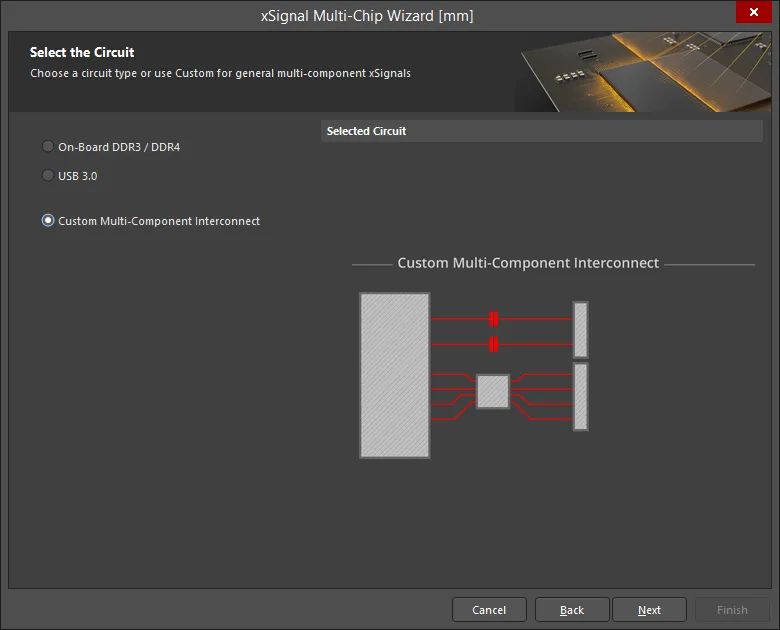
In this mode, the Wizard can be used to define multiple xSignals between a chosen source component and multiple target components. The Wizard is configured over a number of pages. The number of pages depends on the circuit configuration. For example, if there are series terminators, there will be additional pages. The configuration of each page is described below.
Select the Source Component

Use this page to select a single source component. Use the Filter and the Min Pin Count fields at the top of the grid to help locate the component of interest. The * and ? wildcards are supported.
The grids in this Wizard include a right-click shortcuts menu as well as the support of standard Windows multi-select keys. You can also use left-click or the Spacebar to toggle the checkbox of selected items.
Select the Source Nets

Select the nets of interest connected to the chosen source component. Use the Filter and Label fields at the top of the grid to help locate the nets of interest. Only pins with the listed nets will become the sources of the signal routes.
Select Destination Components

Select the desired destination component(s). Use the component Filter and the Min Pin Count fields at the top of the grid to help locate the component of interest.
When you click Next, the Wizard will identify all of the possible xSignals that can be created from the set of nets that have been selected between the chosen components. If the Wizard detects 2-pin components that have both of their pins connected to the chosen nets, these are automatically identified as series termination components and extra Wizard pages will appear later in the process.
xSignal Routes

This page of the Wizard lists the proposed xSignals from each Source Pin through to each Destination Pin. Click on an entry to highlight that xSignal on the PCB.
After analyzing the net paths to identify potential xSignals, the Wizard will then attempt to reduce the set to only list combinations that you are interested in. These are the end-to-end xSignals; the above image shows them between the source and destination components selected in the previous pages of the Wizard. The image also shows that the Wizard has detected series termination component RA1 in each route. RA1 is actually a four resistor pack – in this situation, the Wizard will automatically create logical associations, assuming that each resistor runs across the pack, it will pair the nets that connect to pins that are opposite each other on the component.
Because this assumption that the pins of each resistor are opposite each other might not always be correct, you can select any of the other available outgoing nets using the dropdown in the Dest Pin column. Alternatively, enable the Show all alternative paths option at the top of the grid to display all of the potential combinations of nets that could be used to generate xSignals. Enable the checkbox for each line for which you want to create an xSignal. The enabled xSignals will be added to the class displayed in the Include created xSignals into class field at the bottom of this page. Enter a new name or select one from the drop-down.
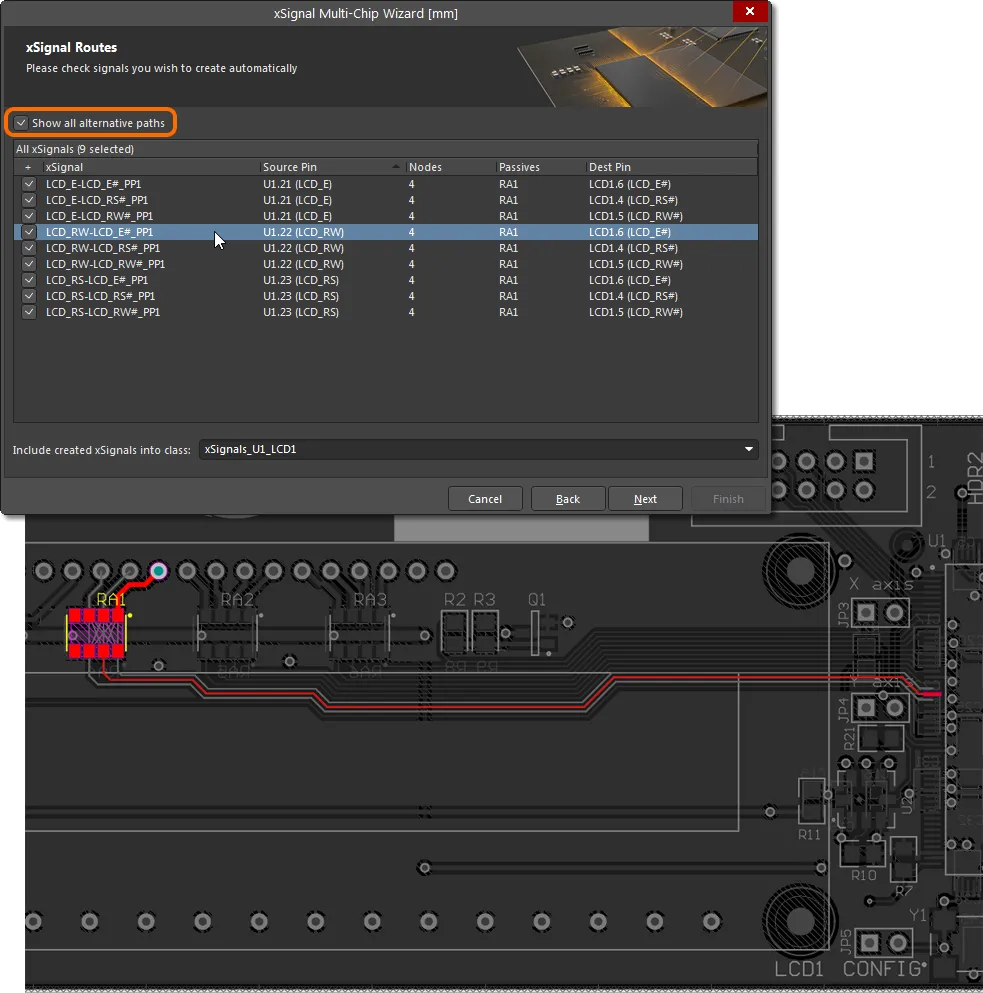
xSignals Length Tuning

This page is used to automatically create a Matched Length design rule for the enabled xSignals. Enable only those xSignals you want to be targeted by this new design rule. If your design requires multiple rules with different requirements, you will be given the opportunity to define additional rules for those xSignals that have not yet had a rule defined later in the process. This first stage will also present the overall end-to-end xSignals. In later Wizard pages, you will have the opportunity to define design rules for the sections within the xSignals – for example, for the output pin to series termination resistor sections.
If you do not want to tune the length of your xSignals, enable No, I don't want to tune the length of my xSignals. No other options on this page will be available if this option is enabled. To be able to edit and access the other options, enable Yes, I want checked xSignals to have the same routed length.
The xSignals Class Base Name field is used to define a name for the currently selected xSignals. Enter a meaningful name, keeping in mind that you may be repeating this process for other xSignals. This set of xSignals will then be targeted by a design rule of the name you enter into the Matched Lengths Rule Base Name field, with the specified Length Tolerance.
Not sure which objects are being targeted? Click on one or more entries to highlight the signal path(s) in the PCB layout.
Source-to-Passives Length Tuning
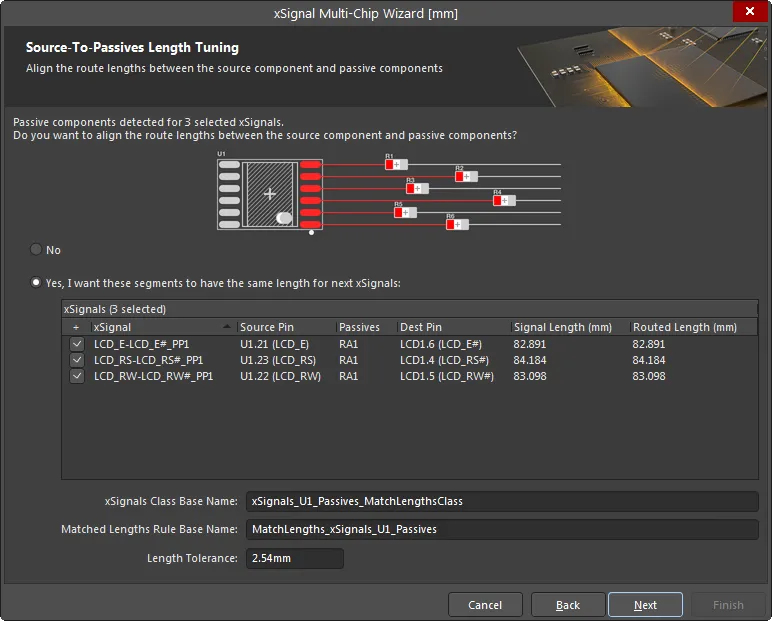
If the set of nets selected include series termination components, additional Wizard pages will appear that give you the opportunity to create additional xSignals and design rules for these sections of the nets. In the above image, you see that this page of the Wizard is being used to create a Matched Length design rule for the chosen xSignals that run from the Source pins to the termination components. If you require xSignals / an xSignal class / a design rule for these, enable the Yes, I want these segments to have the same length for next xSignals option, enable the required xSignals, and define the xSignals Class Base Name, Matched Lengths Rule Base Name and Length Tolerance. Additional xSignals will be created to use with this Matched Length rule.
Passives-to-Destinations Length Tuning
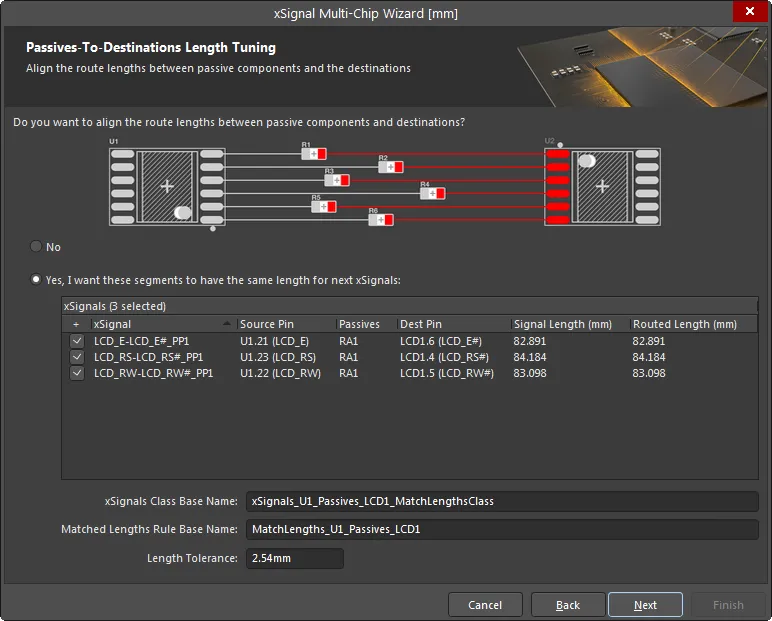
This page is used to create a Matched Length design rule for the chosen xSignals that run from the termination components to the Destination pins. If this is required enable the Yes, I want these segments to have the same length for next xSignals option, enable the required xSignals, and define the xSignals Class Base Name, Matched Lengths Rule Base Name and Length Tolerance. Additional xSignals will be created to use with this Matched Length rule.
Report and Continue
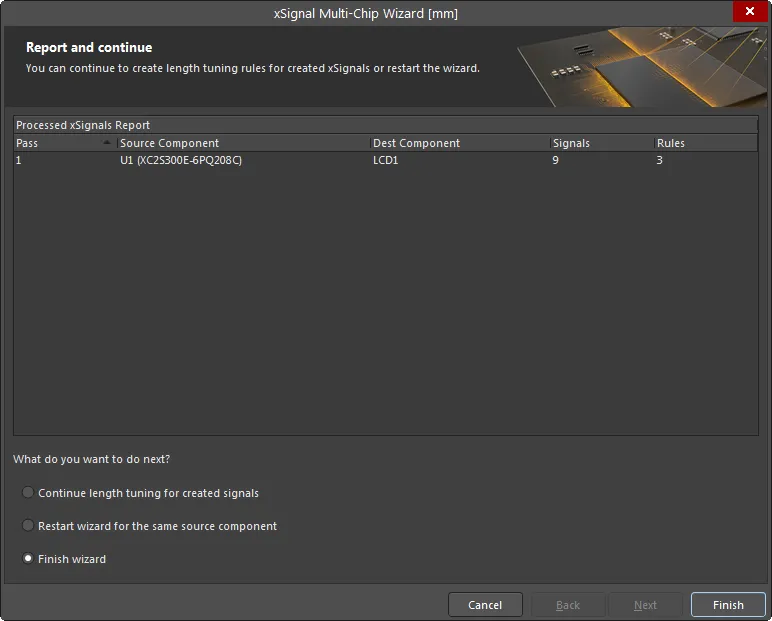
This page of the Wizard will detail the number of xSignals about to be created and the number of design rules about to be created.
At the bottom of the page you can choose to:
- Continue length tuning for created signals – select if you disabled specific xSignals on previous pages and now need to go through the process of defining additional rules for those xSignals.
- Restart wizard for the same source component – select if you want to discard these settings and restart the Wizard with the same components/nets selected.
- Finish wizard – select if you are finished with this source component's xSignal and design rule creation.
xSignals are detailed in the xSignal mode of the PCB panel. Press the Delete key in the panel to remove selected xSignal classes or selected xSignals.

These xSignals are ready for length tuning. To get started, select the Interactive Length Tuning option ( ) from the main Route menu or the Active Bar.
) from the main Route menu or the Active Bar.
You can easily remove a length tuning accordion. Click once on any segment in the accordion to select it, then press Delete.
Note that the existing track segments are broken at the start and end points when you place an accordion. Therefore, if you repeat this tune-then-delete process a few times, you can end up with a straight stretch of routing that is actually made up of many short track segments. To resolve multiple small track segments back into a single segment, run the Design » Netlist » Clean All Nets command from the main menus.
